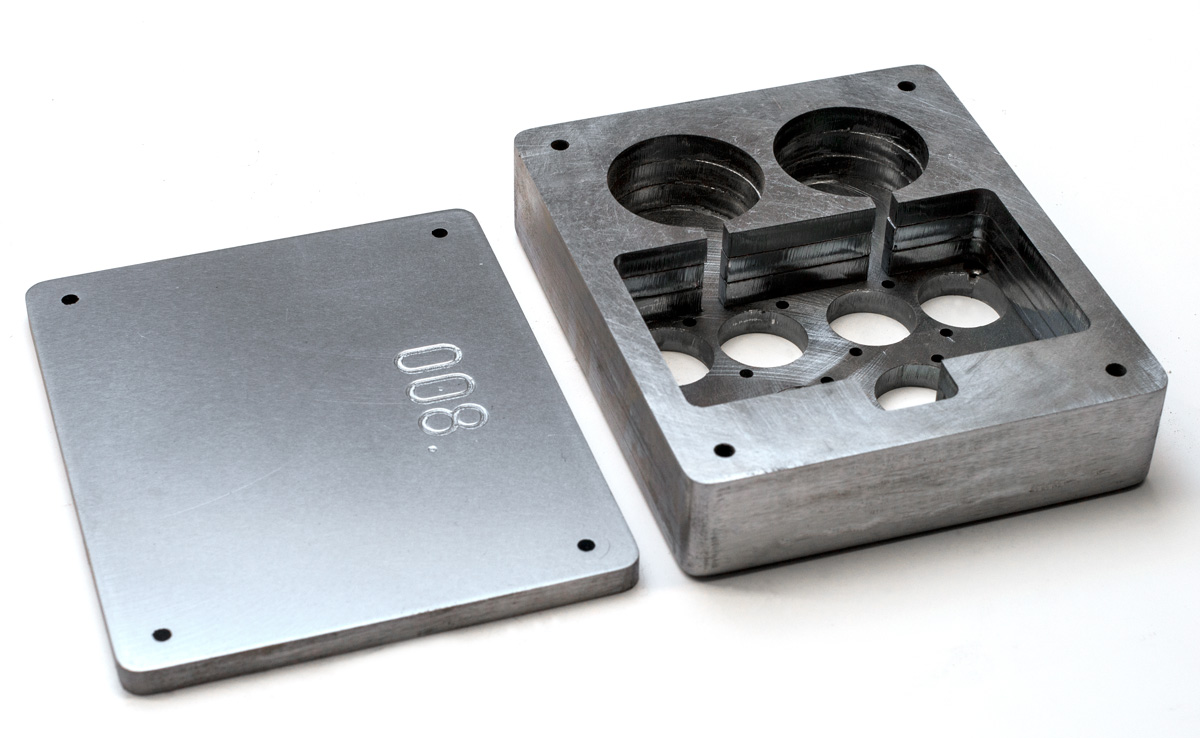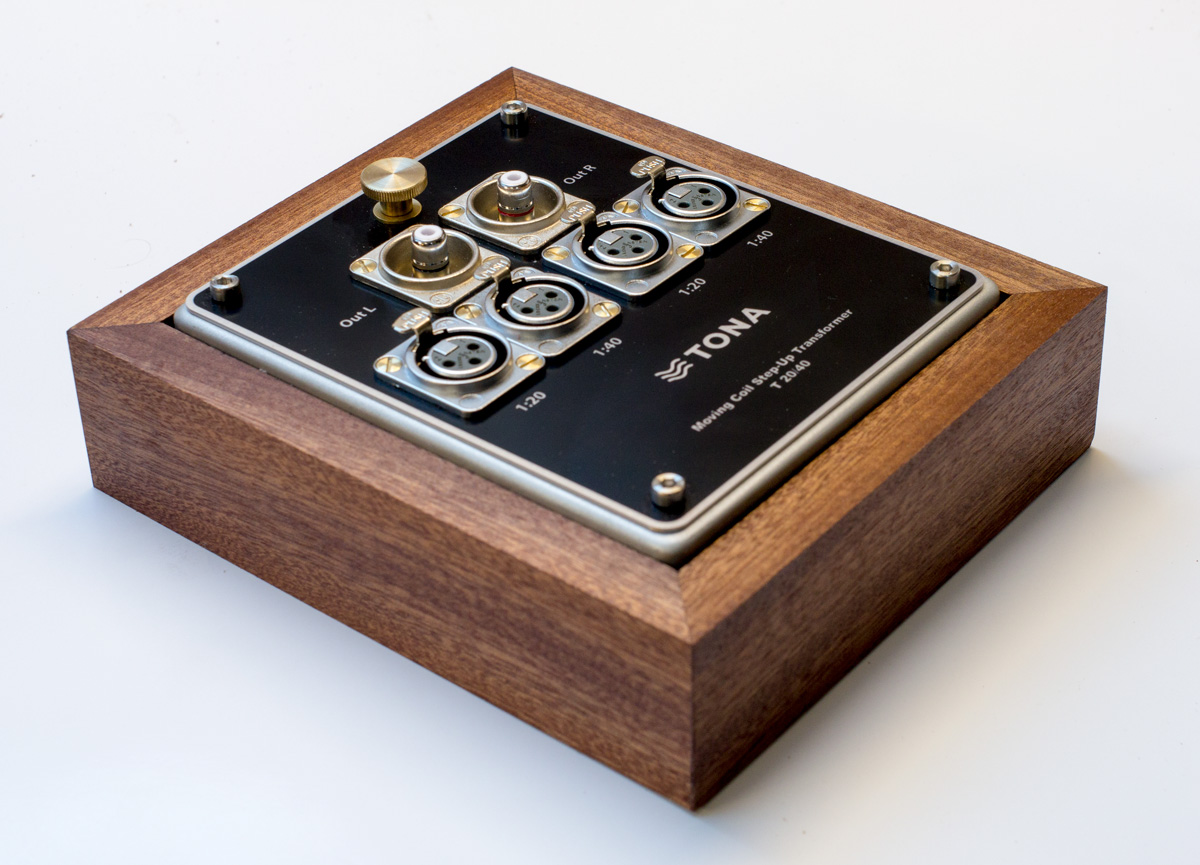A Beaut of a SUT From TONA
Offers both 1:20 and 1:40 gain
Here's an easy way to approach using a step up transformer with a moving coil cartridge: The load that a step-up transformer presents to its primary is calculated when you divide the resistance connected to the secondary with the turns ratio squared. So for the Ypsilon MC16 for instance, it's Rin=47k/16*2=183.5ohms.
To be more precise this stands for an ideal transformer with no winding resistances. So add also 450ohms secondary and 8ohms at primary coil. Rin=47450/16*2+8=193.3ohms.
See how easy this is? Obviously if you are mathlexic as I am, this is difficult. But if you have any hope of living with step up transformers and using the right cartridges with them, it's important to have some of this knowledge and apply it or you might use the wrong cartridge with the wrong SUT and blame the SUT.
In the case of Ypsilon's SUTs, it's possible to use loading resistors at either the primary or secondary side to regulate what resistance the cartridge or the MM phono preamp "sees". That's what presents both the opportunity to perfectly control loading and to confuse the hell out of mathlexics, though I eventually got the formulas down and was able to plug in the numbers, get results, and buy high quality resistors and solder them into Eichmann RCA "Bullet" plugs.
But first, this TONA SUT. It's not some off the shelf transformers housed in a heavy ten pound wooden case, nor does the wood produce the weight. Here's the chassis interior:

The TONA SUT was developed by Gyraf Audio a Danish company located in the very, very nice town of Aarhus. I've been there and it reminded me somewhat of a larger scale Cambridge, MA.— a sophisticated, upscale, college town kind of place, though I was there for only a day so perhaps my impression is off.
Gyraf's products are almost exclusively pro audio in the analog domain. Check out the website and you'll see a lot of really cool looking "knob centric" analog gear based around tubes and "carefully tuned passive circuits". I supposed its CEO Jakob Erland (also described on the site as 'solderer, designer, packer, accountant and marketeer) hangs out at NAMM with EveAnna Manley. They appear to be electronic "birds of a feather".
Mr. Erland developed this transformer with TONA for the consumer moving coil cartridge market. It's available in single-ended RCA and balanced XLR versions, though in balanced it uses the IEC 268-12 pro audio standard that puts pin 3 to ground. Your consumer balanced cables might need rewiring.
Worldwide TONA distribution is through Sallingboe Audio a Danish distributor of a wide range of mostly familiar consumer hi-end audio products. Sonarecoeli a Wisconsin-based retailer handles American sales.
I encountered Dan Sallingboe at Munich High End 2023 and got a good vibe from the transformer so I asked for a review sample, which he sent within a far more reasonable time period than it's taken for me to write this review, for which I apologize.
I asked for the RCA version, which has two sets of inputs 1:20 and 1:40, though both can't be used simultaneously. The 1:20 input produces 26dB gain and a 118 ohm load. The 1:40 produces 32dB gain and a 30 ohm load. 1:20 should be appropriate for cartridges with moderate internal impedances and 1:40 for low internal impedance cartridges like some of the better Ortofons, for instance.
The transformers utilize toroidal nano crystalline cores, wound in-house with the primary side hand-wired with litz type wire requiring a "very strong force" that can only be done by hand, it says on the website.
I don't claim to be so well experienced with transformers that I can explain the sonic differences between various core materials and constructions because I cannot.
Why transformers? The advantage is gain with less pain in terms of added noise though of course transistors now are quiet. Transformer distortion is highest at low frequencies and dropping rapidly at higher frequencies. Solid state distortion characteristics are the opposite. I'm not going to get in the middle of the 'war' between SUT advocates and active circuitry advocates.
Still, there's a lot of voodoo involved in various core and coil materials and there's confusion in the loading and matching side of it. Transformers passively increase voltage but at the same time they decrease current. Impedances are also transformed on both sides of the transformer. A 1:10 transformer plugged into a 47Kohm MM phono preamplifier means the cartridge will see around a 470 ohm load. Conversely, a 3 ohm internal impedance cartridge will produce 30 ohms at the secondary, which is fine into a 47kOhm load—you want at least 10X greater impedance on the input side. This doesn't take into account the effect the cartridge's internal impedance has on the calculations, which is to what the formulas at the top of the story refer. Another transformer issue is hysteresis. When I first purchased the Ypsilon VPS-100 along with a few transformers I discussed these issues with the designer Demetris Backlavas. I've not retained it all, more most but one thing I'm sure of: so much is at play here, it's difficult to accurately predict how a transformer and a cartridge will interact with one other beyond the basics.
I used the TONA with a variety or cartridges including the Lyra Atlas Lambda SL (output .25mV), the Ortofon MC Diamond (.2mV/6 ohm internal impedance and the Verismo (.2mV/7 ohms). I used a variety of phono preamps as well, including the Ypsilon VPS-100, the van den Hul The Grail SX and most recently the CH Precision P10.
Though TONA seems to have designed this SUT for use with vacuum tube based MM phono preamps, I found it compatible with all of them and with all the results were equally outstanding. In fact, I'd say surprisingly transformative when I ran the Lyra AtlasLambda SL into it. Even though Lyra recommends using an SUT designed for 1-2 ohm impedance cartridges (Lyra doesn't spec impedance for some reason), I found the 1:20 sounded better. And that's what I used for the observations below.
For instance, I've been playing a great deal recently Joe Pass Portraits of Duke Ellington (Pablo 2310 716) a 1974 simple trio recording featuring Ray Brown, Pass and drummer Bobby Durham. It's an intimately mic'd "larger than life" production that sounds great through the CH Precision P10 current amplification input. My experience with transformers into phono preamps where it's possible to compare active amplification has been that it's a trade-off: you get improved articulation and even better tracking due to better mechanical damping, but you lose transparency. With better transformers it's a tradeoff more than that the active playback is clearly superior.
In this comparison the TONA's presentation was clearly superior (which shocked and surprised me tbh), with improved articulation of Pass's transient action. Each note became clarified. Textures were "meatier". The same was true of Brown's bass plucks and the overall instrumental texture. Same with Durham's drum taps—more skin and cymbal sizzle. Everything about the presentation was slightly less electronic sounding and more "acoustic". No excess leading edges but also no rounding and softening of transients. It just sounded more natural and real. I was surprised!
Then I moved on to the new Bill Frisell album, Bill Frisell: Orchestras (Blue Note 00602458837483) a which will be reviewed here ASAP. It's a triple LP of Frisell playing live with orchestra recorded in Belgium 2022 and in Italy December 2021 and New Year's Day 2022. There's more to it than that, but for here that suffices. These were live in performance recordings, spatially coherent "big picture" productions, not of the every instrument has a microphone type. There's a wonderful cover of "Lush Life" and two takes of Ron Carter's "Doom", oe with the Brussels Philharmonic and one with the Umbria Jazz Orchestra, but all of that is better covered in a record review.
It's a fine sound triple set originally mastered by Greg Calbi and Steve Falcone at Sterling Edgewater, NJ and cut to lacquer by Joe Nino-Hernes at Sterling, Nashville, TN. It was worthy of at least a 9 for sound until I put it through this transformer and then the upgrade to instrumental textures, and string tone took it easily to 10, maybe 11. Again I was surprised.
But the biggest shocker, and you'll hear this soon on YouTube was when I played an early pressing of the song "Bridge Over Troubled Water" from the album (Columbia KCS 9914). Engineer Roy Halee told me that the master tape of the song had long ago been removed from the tape and that a poorly done substitute has been in its place for many decades including on the Classic reissue and the Mobile Fidelity One Step. You really have to hear an OG to know what you're missing but when I played it through the TONA transformer I found out what I'd been missing! This was easily the best I've ever heard this song sound. Artie's vocals were buttery smooth and perfectly placed. I've never heard the "big strings" sound so vibrant and again well-textured. Honestly, I couldn't believe what I was hearing and I had to play it a second time to be sure it was what I was hearing. I recorded it the second time that's what you'll hear soon. Then you can tell me! I'll record it again through the active section and await comments.
I have another bunch of transformers to review and I'll get to those ASAP.
Conclusion
This TONA transformer is transformative. Whatever Mr. Erland did to produce it, it's got the transformer "secret sauce" in large ladles full. I can't find the precise price but it's around $3500, which is reasonable. If you're in the United States, contact Sonare Coeli and ask about price and also about a money back guarantee audition because transformer/cartridge coupling can be tricky and there's no guarantee it will give you what I heard, though if you've got a Lyra Atlas Lambda SL, chances are good you will.
Specifications
• Developed in-house in Aarhus, Denmark with Gyraf Audio, maker of high end tube audio equipment for the professional market
• Two inputs 1:20 and 1:40
• Mahogany, oak or custom RAL color options
• Connectors can be customized as well the choice of balanced / unbalanced operation
(contact Sallingboe Audio for further details)
• Laminated soft iron case with 8 to 20 mm overall thickness
• Toroidal nanocrystalline transformers wound inhouse.
• The transformers are induction matched in stereo pairs before and after winding
• Matched in stereo within 0.2 dB from 20Hz-20kHz
• -3dB at 4 Hz and 60 kHz (measured with 4Ω cartridge output)
• Hand wired litz primary windings, (the technique involves a very strong force, that can only be applied by hand)
• Stable heavy base accepts all XLR and RCA cables
• 2 years warranty
Connectors
Gold plated RCA connectors.
Silver plated XLR connectors.
Special configurations are possible with custom choice of connectors.
Contact Sallingboe Audio for further details.









































